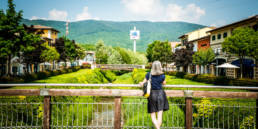Right around this time last year, in the dark rainy days of February, I started to hate my home. We have a ground floor apartment in Florence that is wonderfully located and has lots of advantages, but it’s dark, especially in the main living area. We bought it as newlyweds in 2005 and to compensate for its very standard Italian family layout and décor, I painted everything bright yellow and tried to make it cheery. We kept the kitchen from the old owners, and unfortunately their choice of flooring too – cheap ceramics set on a diagonal with black grout for a crazed maze effect. But the house was functional and we moved in without making major changes. Well, 8 years later it was move or renovate.
It did not take us long to figure out that most things on the market were much worse than our own home, either for location or space… or cost! New constructions were nice but so skimpy on the storage space that we had no idea where we would put our extensive collection of luggage and sports equipment. But we had to address some major problems here. And thus we decided to tear apart pretty much the whole apartment. I mean, you know, it started small, but soon took on its own life. It’s a job that took about 3 months from the first swing of the sledgehammer to the final layer of paint that made it liveable, with finishing touches lasting another few months. We had to move out, and vagabonded around all summer dependent on friends and family – we moved four times in 2.5 months.

Below, read the story of what we did, see the photos of how it turned out, read my tips for brighter ground floor living, more tips you should know before renovating in Italy, and find links to suppliers I came to love and highly recommend.
Here’s what we had to fix: other than intolerable aesthetic issues, we had: (1) a pitch dark living room (the photo below was a very bright day and a very good camera, photoshopped. It never looked like that), (2) loud upstairs neighbours that I was ready to shoot, (3) a front hall closet full of mold and some other humidity issues and (4) entry through the garden directly into the living room, with no space for shoes or coats.

While I have a good sense for interior design, I realized that expert help was required. I called in a designer friend, Stefano Giovacchini, who does colour design consulting and application of designs on walls. He brought along his architect colleague Francesco Fazzi. They listened to our observations, took measurements, and immediately thought of solutions that had never crossed my mind. Francesco noticed the way that what little light entered through the french doors from the garden was blocked by a wall dividing the kitchen from the living room. And so we decided to tear down that wall. A few months went by deciding on a final floor plan, materials, costs, and the contractor who would carry it out. And permits. Waiting for permits.
Here is the floor plan we decided on. The red indicates demolitions, while the yellow is new construction in plasterboard. The intervention involves mainly the ‘day area’ – kitchen, living and dining area. Besides the walls, we also changed the height of the space which had been lowered by drop ceilings.

While waiting for the paperwork to go through, we made our final choices about materials. In this, we were lucky to have chosen an all-in-one contractor, Miro, who was able to provide many of the materials through stock contacts. Mirko found us great stock deals on the grès used in the bathroom, kitchen and entranceways. Here you see Mirko and Francesco holding potential wood samples in natural light. The one I wanted cost 156 euros per square meters. Obviously I had to choose something that cost half that…

Mid June, 2012. We’ve moved out and are trying to monitor the renovation daily while living in an apartment borrowed from a friend, in the midst of a heat wave. My kitchen looked like this (did I mention that that wall was a supporting wall and thus required major I-beam insertion not to mention extra paperwork?). The bathroom wasn’t faring much better. The dust from the torn-out drop ceilings was just settling. I felt strangely calm.

There are two months’ more photos similar to this one but I will spare you the details. The process of stripping the house down to its bare essentials helped us understand that we made the right choice: we have very high ceilings and good space, including lots of storage. The windows are a bit small, but with professional help we were able to make the most of them. When it came time to mount the new drop ceilings we made them as high as possible while leaving space to hide tubes. The previous ceiling actually stepped down lower as one got away from the door/ light source, badly thought out by the previous residents. We made ours flat, except for one corner which forms a triangle and comes down at an angle, made to reflect the light from what is essentially the centerpiece of this project, a custom made LED lamp. The construction guys had a ball trying to make this angle support the weight of the materials.

Finally the time came to see the design made real. Stefano showed me the paint colours in person and proceeded to apply the backsplash of the kitchen, which is a special kind of paint coated with layers of wax that seal and create thickness on the wall. After so much black grouting, I invented a house with no grout. As for the colours, they are all natural, calming colours. Even the yellow, of which I was royally sick, is a natural earth tone very different from the jarring one I had chosen before.

After much micro managing, our house was done. We still have to find solutions for some of the spaces, but all in all, we’re much happier here now. The space is brighter, more functional, and more healthy. How did we address the issues we had before in order to be satisfied with the new/old home?
1) Light: new layout, colours, reflective materials, and more (see below)
2) The neighbours. I hired two guys named Rocco and Vinnie to take them out. Just kidding. Mirko made our bedroom into a padded cell with natural cork boards on the ceiling and the wall that contains pipes that allowed me to hear the signore upstairs making morning pipì at 6:10am. We still hear them fighting sometimes but I am much less homicidal now.
3) The mold. Turns out that, other than residue from a previous flooding problem, water was infiltrating from the hideous tiled shower stall into the wall, causing the whole front hall closet to be useless for the storage of coats. Just in case, a slice of wall was basically cut out and filled in with impermeable materials that block any water that wishes to come up from the foundations of the apartment. Other humid areas of plaster have been fixed and we’ve installed air conditioning and dehumidifiers throughout.
4) The entrance hall was created by sacrificing one square meter of kitchen.
What does it look like now?
Satisfy your curiosity!







Before renovating in Italy you need to know…
You need a permit if you’re making any changes to the inside of your house that involve breaking tiles, and touching pipes or wires. Currently this is a relatively simple DIA, or declaration to the city that you’re starting a renovation and you can start the day you file. However, if you are changing volumes of space in relation to openings, or if you are taking out supporting walls, there is further paperwork that needs to be filed by a civil engineer and that takes time to process. If you’re using a construction company, along with the DIA you need to provide certain certifications and information about the company that must be in good order. Hiring an architect or Geometra to do this is the only way to save the hair on your head. Do find out the costs of all these permits and the processing cost by your architect or geometra and calculate that into your total budget.
Second, find out what fiscal breaks there are for renovation at the time you start. I was very lucky that, while we waited for our paperwork to go through, the deduction for renovation of any type passed from 36 to 50% of the total cost! There are further tax breaks for energy saving elements. This money will (supposedly) be given back as a tax break over the next 10 years. To take advantage of these tax breaks you need to be a resident and you have to pay all the suppliers with a special form at the bank, on which you also declare the permit number of your renno job. For energy saving renovations, you need a further declaration (study) by an engineer, which may cost you more to get than the amount you’d get back on taxes.
If you have money set aside, renovating during this moment of crisis can be advantageous. We found that Miro, especially, was very happy to take on our job even at the expensive of commuting from Lucca to Florence each day. They were 30% cheaper than suppliers in Florence and 100% more dedicated because they sent a whole team each day to our home, rather than local companies who often have contractors on multiple projects at once. Good prices can be found now on supplies, either through stock or online. The fiscal advantage is also good right now. For the cost of moving, considering transport, taxes, notary etc, we have made our house the way we always wanted it.
Tips for happy ground floor living
- Use natural, light colours. Bright colours create false happiness. The whitewashed wood floors I chose make a huge difference.
- We also painted wooden doors white. Despite the fact that they were good quality solid wood, they made the place look really old fashioned, while the white makes it seem new and bright.
- Use lots of glass doors. Frosted glass is nice.
- Buy good quality lamps. We used to have a ton of built-in lighting (badly thought out by the previous owners) plus an assortment of cheap lamps from Ikea and Leroy Merlin. Out with the cheap, in with Artemide. Above our couch we have the Artemide Talo with a bright halogen bulb, while the globe-like kitchen lamp is also Artemide, the Dioscuri, used also in the hallway in a smaller size. Above the table is a custom made lamp designed by Stefano Giovacchini.
- For security gates on the external french doors, we had the classic ‘Spagnoli’ accordion type that most homes have in Florence. Changing to hand-forged iron bars made a huge difference in the amount of light that passes through.
Recommended suppliers
- Design by Disegno Design, Lucca (Stefano Giovacchini)
- Architecture by Francesco Fazzi (no website)
- Construction by Miro, Lucca (Mirko) – good prices, precise work, reliable workers and very very patient!
- Kitchen by Cesar, bought at Personal Cucina, Lucca – best price for quality and style
- Artemide lamps from Design Luce (excellent prices)
Sign up to receive future blog posts by email
Alexandra Korey
Alexandra Korey aka @arttrav on social media, is a Florence-based writer and digital consultant. Her blog, ArtTrav has been online since 2004.
Related Posts
December 31, 2023
How sewing saved my sabbatical
April 30, 2022




